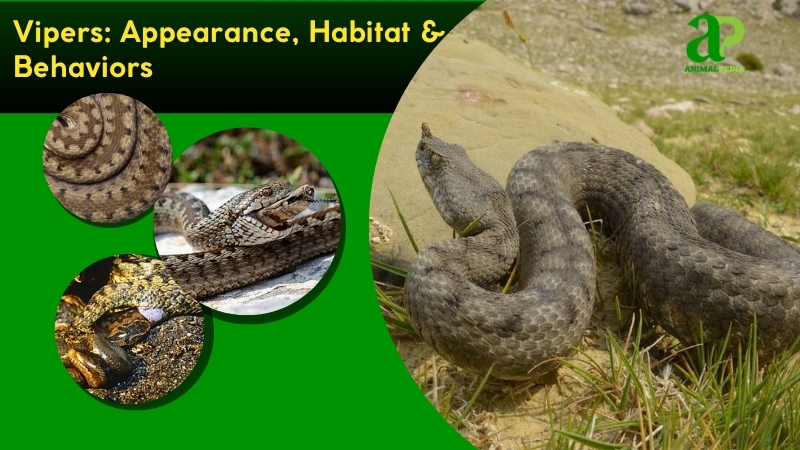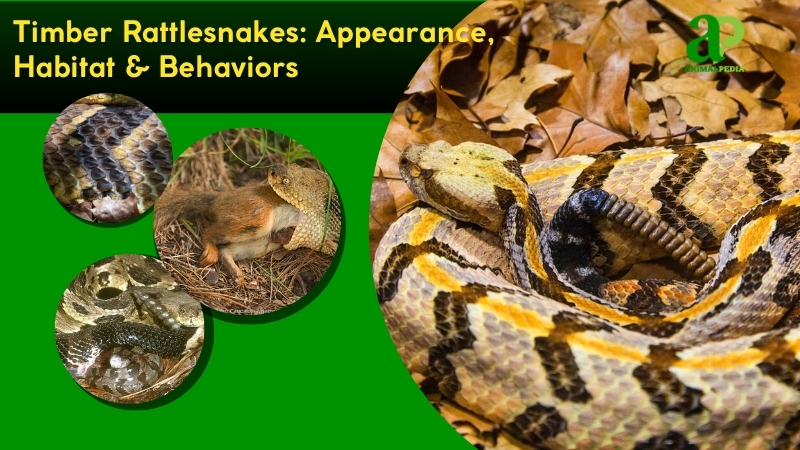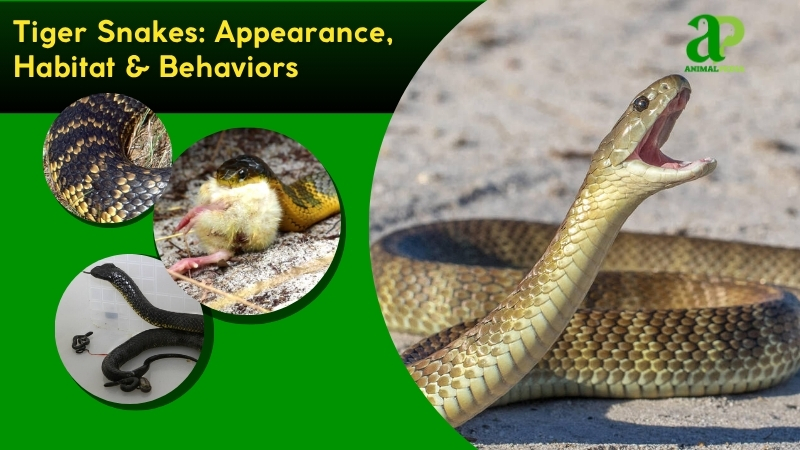Dekay’s Brownsnakes (Storeria dekayi) are small, non-venomous colubrids found across much of North America, from southern Canada to Central America. Common in gardens, forests, and city edges, they thrive in cover-rich habitats and consume soft-bodied invertebrates. Typically measuring 9–13 inches (23–33 cm), these secretive snakes are highly adaptable and often go unnoticed.
This comprehensive guide covers diet patterns, size variations, predator relationships, and longevity factors for North America’s most adaptable urban snake species.
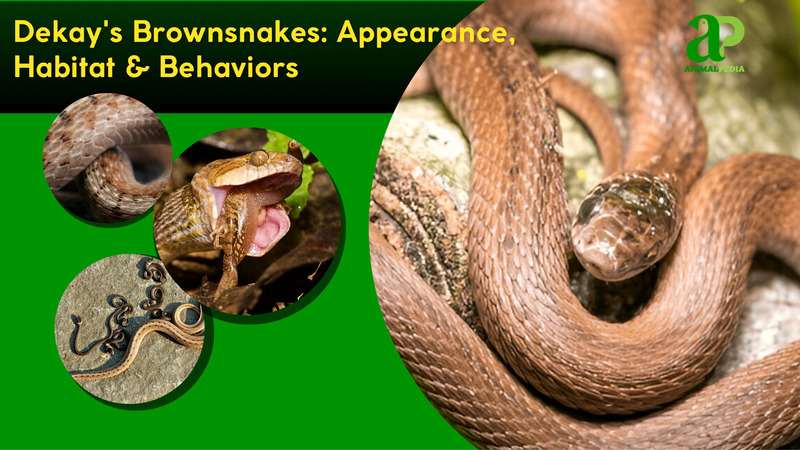
What is a Dekay’s Brownsnake?
The Dekay’s Brownsnake (Storeria dekayi), also known as the Northern Brownsnake, is a small, slender reptile characterized by a brown or gray body with a lighter central stripe flanked by two rows of dark spots. The ventral side is typically pale, often with dark speckling. This coloration provides excellent camouflage among leaf litter, rocks, and soil, allowing them to remain hidden from both predators and prey.
Dekay’s Brownsnakes are fossorial, spending much of their lives beneath debris, rocks, logs, or in loose soil. Their range includes diverse habitats—woodlands, wetlands, gardens, vacant lots, and even roadside ditches—making them one of the most urban-tolerant snake species in North America. Their adaptability to disturbed areas and secretive behavior help them persist in areas heavily modified by human activity.
Diet primarily consists of soft-bodied invertebrates, especially earthworms, slugs, and snails. Regional variation in prey preference has been observed, with slugs more frequently consumed in northern habitats and earthworms dominating southern diets. Dekay’s Brownsnakes use mild venom and specialized teeth to subdue prey, although they pose no threat to humans. When threatened, they rarely bite, instead relying on defensive behaviors such as emitting foul-smelling musk or remaining motionless.
Breeding occurs in spring, typically April to May, following winter brumation. The species is viviparous, giving birth to 3–20 live young in late summer (July–September). Newborns measure about 3–4 inches (7.6–10 cm) in length and are independent from birth. Females do not exhibit parental care, and juveniles begin feeding on tiny invertebrates immediately. Maturity is reached in 2–3 years, and individuals may live up to 5–7 years in the wild.
Despite their small size and secretive nature, Dekay’s Brownsnakes serve a vital ecological role in regulating populations of invertebrate pests. They are preyed upon by larger snakes, birds, and mammals such as shrews or weasels. While often overlooked due to their inconspicuous lifestyle, their presence in gardens and parks makes them valuable allies in natural pest control.
Now that we understand what Dekay’s Brownsnakes are, let’s take a closer look at their appearance and how it supports their subterranean survival strategies.
What Do The Dekay’s Brownsnakes Look Like?
Dekay’s brownsnake, a small natricine colubrid, has a slender, cylindrical body, typically 9–13 inches (23–33 centimeters) long, weighing 0.04–0.08 pound (0.02–0.04 kilogram). Its coloration is uniform brown or grayish-brown, often with two rows of dark dorsal spots, blending seamlessly into leaf litter. The skin, covered in smooth scales, feels soft, aiding inconspicuous movement. Key features include a slightly pointed head, small dark eyes with round pupils, a forked tongue for chemosensory navigation, a thin neck, and a limbless body tapering to a short, pointed tail without claws. They slither 0.1–0.3 miles (0.2–0.5 kilometer) daily, foraging in moist habitats (Ernst & Ernst, 2019).
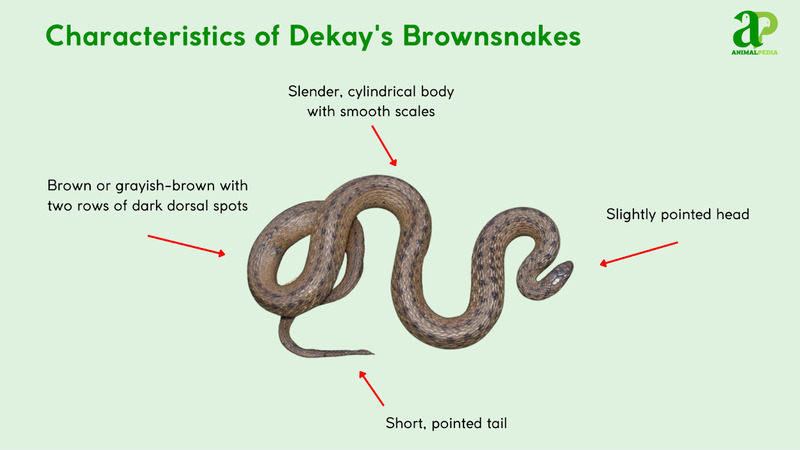
Compared to the red-bellied snake (Storeria occipitomaculata), Dekay’s brownsnake lacks the vivid reddish belly, featuring a pale or cream-colored ventral surface instead. Unlike garter snakes (Thamnophis sirtalis), which have bold stripes, its subtle spotting and smaller size (up to 50% shorter) are distinctive. The keeled scales of garter snakes contrast with the brownsnake’s smooth scales, enhancing its cryptic appearance in urban and forest settings (Willson & Dorcas, 2017).
How Big Do Dekay’s Brownsnakes Get?
DeKay’s Brownsnakes size is around 9–13 inches (23–33 centimeters) in length and weigh 0.02–0.04 pounds (10–20 grams). Their small, slender bodies suit secretive, fossorial lifestyles across North American habitats. Adult snout-to-tail length typically ranges from 9–15 inches (23–38 centimeters) (Means, 2017).
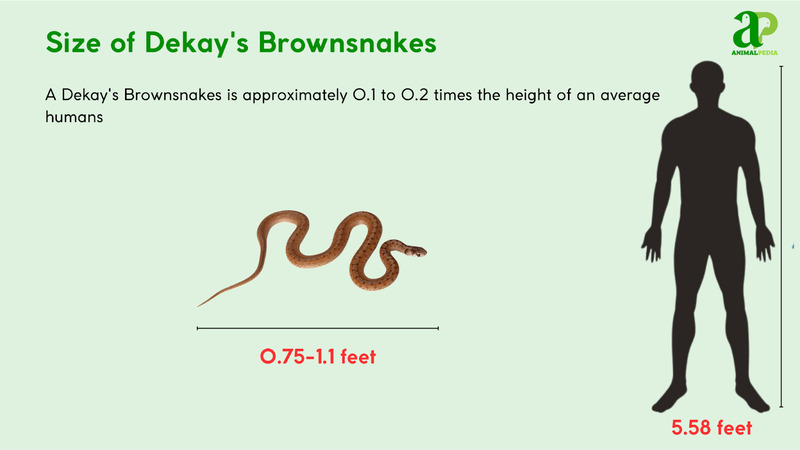
The longest recorded specimen measured 20 inches (50.8 cm) and weighed 0.05 pounds (25 grams), found in Pennsylvania’s Erie County (Gray, 2016), making them 40% smaller than similar species like Red-bellied Snakes.
Females are slightly longer and heavier, averaging 10–15 inches (25–38 centimeters) and 0.03–0.05 pounds (15–25 grams), while males range from 9–12 inches (23–30 centimeters) and 0.02–0.04 pounds (10–20 grams). Sexual dimorphism is subtle, with females having thicker bodies for viviparity.
| Trait | Male | Female |
| Length | 9–12 in (23–30 cm) | 10–15 in (25–38 cm) |
| Weight | 0.02–0.04 lbs (10–20 g) | 0.03–0.05 lbs (15–25 g) |
What Are The Unique Physical Characteristics Of The Dekay’s Brownsnakes?
DeKay’s Brownsnakes are distinguished by their keeled scales and a faint middorsal stripe, unique among small North American colubrids. Unlike similar species, they possess 17 dorsal scale rows at midbody, a trait rare in sympatric snakes, enhancing identification (Means, 2017).

The keeled scales, with a central ridge, provide traction in moist, leaf-litter habitats, aiding fossorial movement. The middorsal stripe, a lighter brown or gray band, runs from neck to tail, distinct from the uniform or spotted patterns of other brown snakes like Storeria occipitomaculata. Studies confirm this stripe’s role in camouflage, blending with soil and debris, reducing predation by birds and mammals. Their small size, 9–13 inches (23–33 centimeters), and lack of vibrant markings further differentiate them, optimizing their secretive lifestyle (Hecnar & Hecnar, 2016).
How Do Dekay’s Brownsnakes Adapt With Its Unique Features?
DeKay’s Brownsnakes survive in the wild using keeled scales and a middorsal stripe for camouflage and traction. These features blend them into leaf litter, evading predators and aiding nocturnal foraging in diverse North American habitats (Means, 2017).
Keeled scales enhance grip, facilitating movement through moist soils. Acute chemosensory tongue detects prey scents, optimizing hunting efficiency. Sharp eyesight spots subtle invertebrate movements, improving nocturnal predation. Slender body enables burrowing, accessing hidden microhabitats for safety and thermoregulation. These adaptations ensure effective predator avoidance and prey capture, supporting their ecological role (Hecnar & Hecnar, 2016).
Anatomy
DeKay’s Brownsnakes’ anatomy supports their secretive, fossorial lifestyle in North American ecosystems. Compact systems optimize energy efficiency and predation on soft-bodied invertebrates, ensuring survival in varied habitats like forests and urban gardens (Means, 2017).
- Respiratory System: Single functional lung facilitates efficient oxygen exchange, supporting low-energy burrowing in moist soils.
- Circulatory System: Three-chambered heart sustains moderate activity, delivering oxygen for nocturnal foraging in leaf litter.
- Digestive System: Short tract with potent enzymes rapidly digests slugs and earthworms, maximizing nutrient absorption.
- Excretory System: Kidneys produce uric acid, conserving water in dry, urbanized environments with sparse moisture.
- Nervous System: Sensitive neurons enhance chemosensory detection, aiding prey location and predator avoidance in dense cover.
These systems enable DeKay’s Brownsnakes to thrive as inconspicuous predators. Their anatomy supports quick escapes and efficient feeding, maintaining ecological balance in invertebrate control (Hecnar & Hecnar, 2016).
With their modest appearance perfectly suited for concealment, these snakes are remarkably well-adapted to a wide variety of environments across their range.
Where Do Dekay’s Brownsnakes Live?
DeKay’s Brownsnakes are distributed across eastern North America, from southern Ontario and Quebec to Mexico, Guatemala, and Honduras. They concentrate in the U.S. Northeast, Midwest, and Southeast, notably Pennsylvania’s Erie County and Ohio’s Cuyahoga Valley, avoiding islands like Nantucket (Means, 2017).

Their habitats include deciduous forests, grasslands, and urban areas like gardens and vacant lots, with moist soils, leaf litter, and rocks. These environments provide cover and abundant invertebrate prey, ideal for fossorial behavior and thermoregulation. Fossil records suggest their presence for over 1.5 million years, with no significant migration; local movements follow prey. Studies confirm their adaptability to disturbed habitats, explaining their persistence in urban settings (Hecnar & Hecnar, 2016).
How Do Seasonal Changes Affect Their Behavior?
DeKay’s Brownsnakes adapt behaviors across four seasons, aligning with prey availability and climate in North American habitats. These shifts optimize foraging and reproduction (Means, 2017).
- Spring (March–May): Emerge from brumation; mate and forage nocturnally for earthworms.
- Summer (June–August): Peak activity; females birth live young, feed heavily on slugs.
- Autumn (September–November): Reduce movement; stockpile prey, prepare for brumation under rocks.
- Winter (December–February): Brumate in burrows, cease feeding, conserve energy until spring.
These behaviors enhance survival, controlling invertebrate populations and evading predators (Hecnar & Hecnar, 2016). Their seasonal rhythms also help maintain ecosystem balance by synchronizing predator-prey interactions with environmental cycles.
Their success across such a broad range of habitats is closely tied to their discreet and adaptable behavior, which allows them to thrive even in urban settings.
What Is The Behavior Of Dekay’s Brownsnakes?
DeKay’s Brownsnakes exhibit secretive behaviors, thriving in North American habitats. These nocturnal, fossorial snakes optimize predation and defense, shaped by ecological pressures (Means, 2017). Their cryptic lifestyle allows them to persist even in fragmented urban and suburban environments.
- Feeding Habits: Ambush earthworms and slugs, using specialized teeth. Diet shifts regionally, favoring slugs in northern ranges.
- Bite & Venomous: Non-venomous; bites are rare and harmless to humans. Defensive musk deters threats.
- Daily Routines and Movements: Nocturnal; hide under rocks or logs daytime. Minimal movement conserves energy.
- Locomotion: Slither with keeled scales, adept in leaf litter. Burrowing aids foraging and escape.
- Social Structures: Solitary, except during spring mating. No complex social hierarchies observed.
- Communication: Use musk and body postures for defense, pheromones for mating (Hecnar & Hecnar, 2016).
Their feeding habits drive ecological roles, controlling invertebrate populations. Exploring these strategies reveals their impact on soil ecosystems. By maintaining invertebrate balance, they contribute significantly to nutrient cycling and ecosystem health.
What Do Dekay’s Brownsnakes Eat?
Dekay’s Brownsnakes eat primarily earthworms, slugs, and snails, consuming 2-4 prey items per feeding session every 3-5 days during active months. Adults require 15-20 earthworms weekly, while juveniles consume 5-8 small invertebrates per week. Northern populations feed 70% on slugs, while southern populations prefer 80% earthworms, with seasonal shifts toward increased slug consumption during wet periods (May-September).
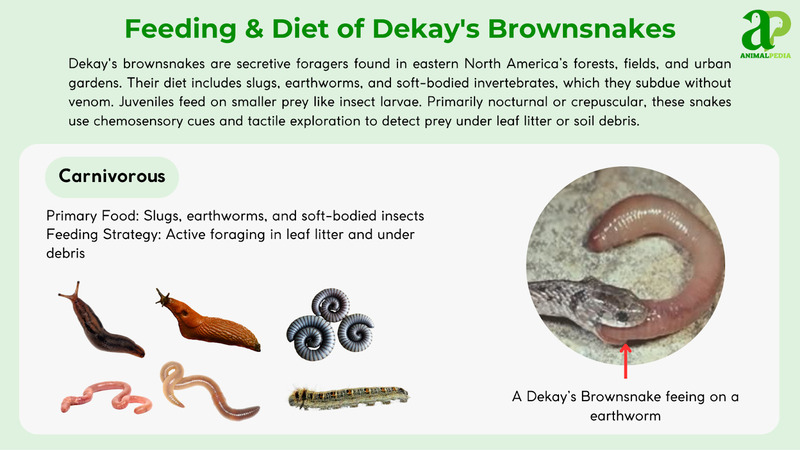
- Diet by Age:
Hatchlings start with tiny prey such as small earthworms and insect larvae, limited by their narrow jaw gape. As they grow, juveniles begin targeting larger worms and soft-bodied slugs. Adults consume a broader range, including slugs, earthworms, and occasionally small amphibians, showing progressive dietary adaptability across life stages.
- Diet by Gender:
Males and females of DeKay’s Brownsnakes generally consume the same invertebrate prey, mainly earthworms and slugs. However, gravid females often increase slug intake during gestation to meet heightened metabolic demands. Despite these subtle variations, the overall diet shows strong overlap, reducing intraspecific competition and maximizing foraging efficiency.
- Diet by Seasons:
During spring and summer, DeKay’s Brownsnakes feed actively on abundant worms and slugs, aligning with peak biological activity and reproductive periods. In autumn, feeding tapers off as they prepare for winter brumation. Winter brings a complete halt to feeding, with individuals relying on stored fat reserves to survive.
How Do Dekay’s Brownsnakes Hunt Their Prey?
Dekay’s brownsnakes rely on their sense of smell to locate small creatures like worms, slugs, and insects. Once they pick up a scent, they swiftly and quietly move towards their target.
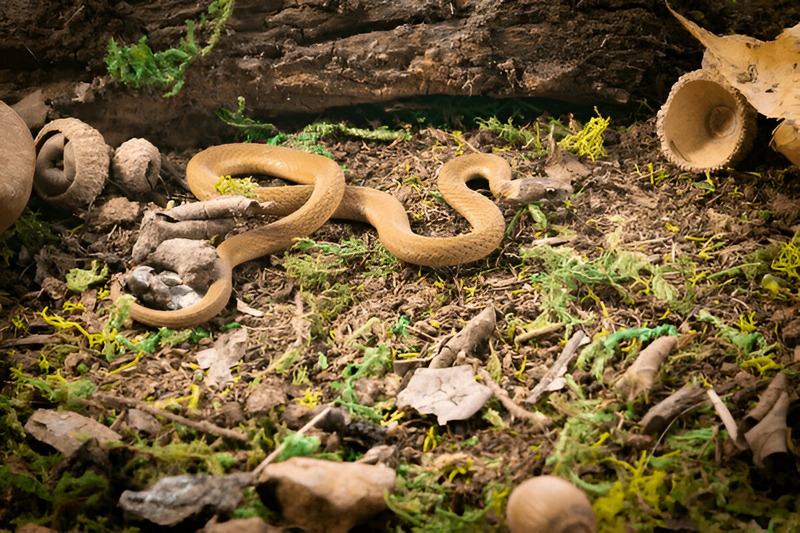
These brownsnakes are skilled at stalking their prey, using a mix of stealth and speed to catch their meals without being noticed. They patiently wait for the right moment to strike, then quickly attack their unsuspecting prey with decisive force.
Despite their small size, Dekay’s brownsnakes are effective hunters, using their natural abilities to survive in their environments. Observing these snakes in action showcases their remarkable adaptations that make them successful predators in the wild.
Are Dekay’s Brownsnakes Venomous?
Dekay’s brownsnakes don’t possess venom, making them safe and harmless to encounter. These small snakes rely on mimicry and camouflage for defense and hunting, rather than venom. Their lack of venom means that you can observe them up close without worry.
When hunting, they use their sharp teeth located at the back of their mouths to capture and immobilize prey. This non-venomous characteristic allows you to appreciate the beauty and unique qualities of Dekay’s brownsnakes without any fear of venomous bites.
When Are Dekay’s Brownsnakes Most Active During The Day?
Dekay’s brownsnakes are most active during the early morning and late afternoon. At these times, they enjoy exploring their surroundings when the temperatures are optimal.
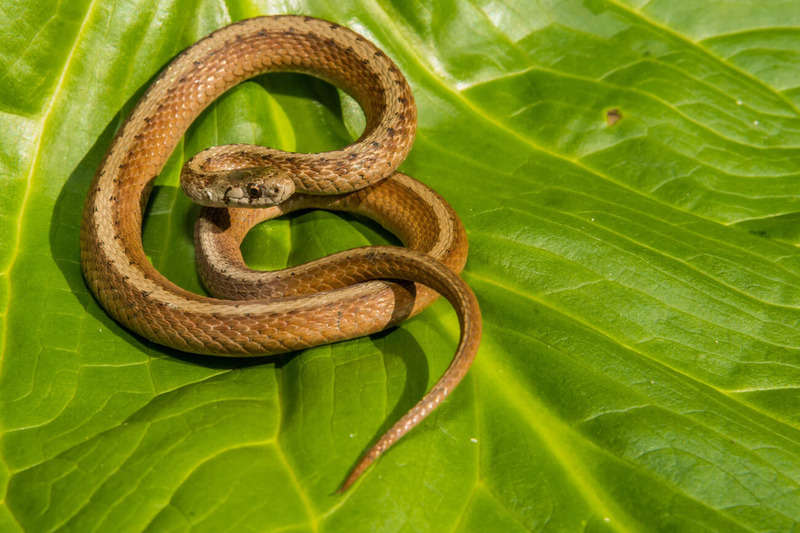
In the morning, they come out of hiding to soak up the sun’s warmth, which jumpstarts their day. You can often see them moving through grassy areas or near water sources, searching for food like insects, worms, and slugs.
As the day cools down, they become active again in the late afternoon to continue hunting. So, keep an eye out for these curious creatures during their active periods for a chance to observe them in their natural habitat.
How Do Dekay’s Brownsnakes Move On Land And Water?
Dekay’s brownsnakes move gracefully and efficiently both on land and in water. On land, these slender creatures slither in a unique zigzag motion, smoothly propelling themselves forward by moving from side to side. They use their scales to grip the ground, allowing them to navigate various terrains with ease.
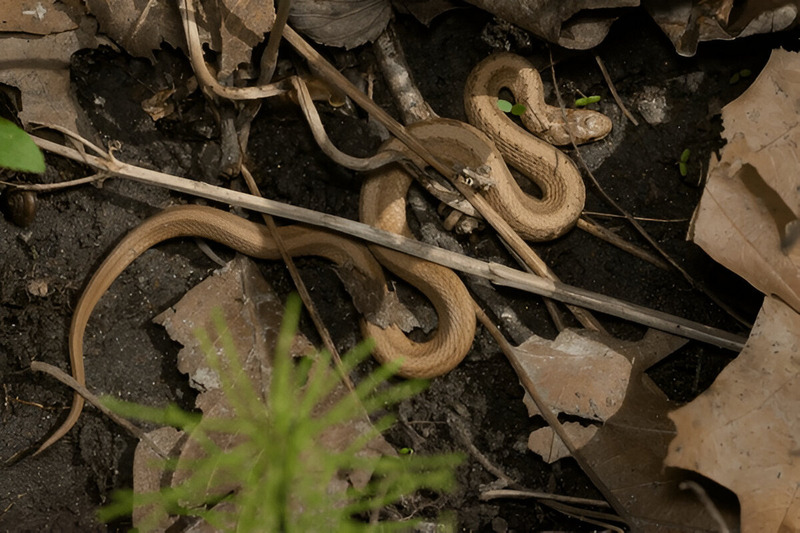
When encountering water, Dekay’s brownsnakes showcase impressive swimming skills. Their streamlined bodies enable them to glide effortlessly through shallow water bodies, using subtle movements to steer and explore their aquatic surroundings. Although not commonly found in deep water, these snakes exhibit agile maneuvering abilities in shallower areas.
Their adaptability in adjusting their movements based on the environment highlights their agility and versatility. Dekay’s brownsnakes demonstrate a blend of grace and efficiency whether on land or in the water, showcasing their ability to explore their habitats with ease.
Do Dekay’s Brownsnakes Live Alone Or In Groups?
Dekay’s brownsnakes are known for their preference for a solitary lifestyle. These snakes tend to live alone rather than in groups, enjoying their independence in the wild. Foraging for food and soaking up the sun are activities they typically do solo.

Unlike some snake species that form groups, Dekay’s brownsnakes are content exploring their surroundings on their own. This independent behavior allows Dekay’s brownsnakes to focus on hunting insects, slugs, and worms without any distractions. It also gives them the freedom to choose their resting spots without having to share.
While they may interact with other snakes occasionally, especially during mating season, Dekay’s brownsnakes generally lead peaceful lives on their own in their natural habitats. So, if you encounter one in the wild, remember that it’s likely enjoying its solo adventures.
How Do Dekay’s Brownsnakes Communicate With Each Other?
Dekay’s brownsnakes rely on subtle behaviors like leaving pheromones to attract potential mates. When encountering another snake, they might use body language such as touching or rubbing against each other. Additionally, they utilize their tongues to flick out scents and gather information about their surroundings or detect prey.
In moments of danger, Dekay’s brownsnakes can hiss, vibrate their tails, or even play dead to warn off predators. While they may not hold conversations like humans, these snakes have developed clever ways to exchange information in their natural habitat.
Alongside their secretive habits and resilience, Dekay’s Brownsnakes also display fascinating reproductive strategies that support their survival across diverse environments.
How Do Dekay’s Brownsnakes Reproduce?
DeKay’s Brownsnakes reproduce viviparously, giving birth to live young. Breeding begins in spring (April–May) post-brumation. Males pursue females using pheromone trails, engaging in tactile courtship by coiling and chin-rubbing. Females remain receptive, with mating lasting hours.
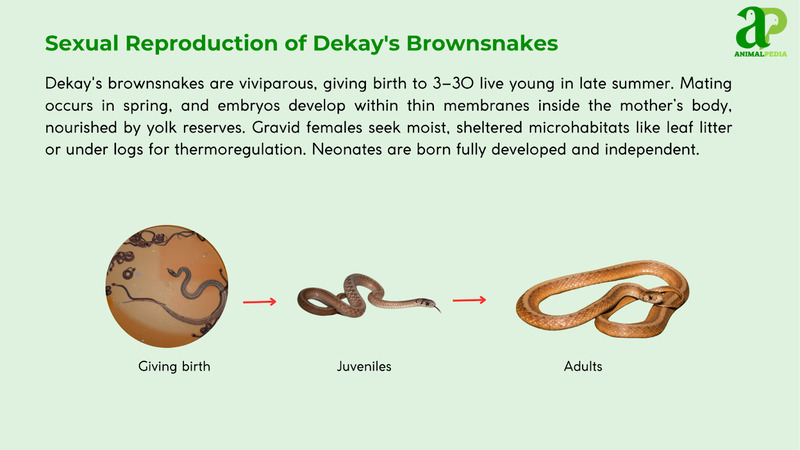
Post-mating, females gestate for 2–3 months, birthing 3–20 live young in July–September. Each neonate, weighing about 0.007 ounces (0.2 grams), measures 3–4 inches (7.6–10 centimeters). Birth occurs in concealed sites like leaf litter or under logs, offering protection. Females provide no further care; males depart post-mating. Habitat disturbance, like urbanization, can reduce litter size, as noted in Ohio studies (Hecnar & Hecnar, 2016).
Neonates are independent, feeding on tiny invertebrates. They grow rapidly, reaching maturity in 2–3 years. The life cycle spans 5–7 years, with urban populations facing higher mortality from human activity. Their viviparity enhances survival in cooler climates, but low reproductive rates necessitate habitat conservation (Means, 2017).
How Long Do Dekay’s Brownsnakes Live?
Dekay’s Brownsnakes typically live 7 to 10 years in the wild, although some individuals have reached 12 to 15 years in captivity (Hecnar & Hecnar, 2016). Lifespan is influenced by several ecological and biological factors. In natural environments, predation from birds, mammals, and larger snakes significantly shortens their lives—often by as much as 40%. Urban populations also face higher mortality rates due to threats like road traffic and pollution, resulting in an average lifespan of only 5 to 7 years. In contrast, snakes living in undisturbed forests or protected reserves can achieve maximum longevity.
Although males and females generally have similar lifespans, minor differences may arise. Females often expend more energy during reproduction, which can marginally affect survival, though current evidence suggests this impact is limited.
In captivity, Dekay’s Brownsnakes benefit from predator-free environments, consistent feeding, stable temperatures, and access to healthcare. These factors dramatically improve their chances of longevity, often allowing them to live several years longer than their wild counterparts. Under optimal care, captive snakes can reach up to 15 years of age, showcasing the resilience and adaptability of this modest yet widespread species.
While their reproductive strategies help maintain stable populations, Dekay’s Brownsnakes are not without natural threats and predators in the wild.
What Are The Threats Or Predators That Dekay’s Brownsnakes Face Today?
DeKay’s Brownsnakes face threats from habitat loss, road mortality, and pesticide exposure. Predation and human activities further challenge their survival across North America, particularly in urbanizing regions (Means, 2017).

- Habitat Loss: Urban development fragments forests and grasslands, reducing populations by 15–25% in affected areas.
- Road Mortality: Vehicle collisions kill thousands yearly, especially during nocturnal foraging, disrupting local colonies.
- Pesticide Exposure: Chemical runoff diminishes prey like slugs, lowering reproductive success by 10–20%.
Dekay’s Brownsnakes predators include birds (owls, hawks), larger snakes (rat snakes, kingsnakes), and mammals (weasels, raccoons). Juveniles are most vulnerable due to their small size, while adults use musky secretions and camouflage for defense.
Human impacts, notably suburban expansion and pesticide use, degrade habitats and reduce prey availability. Research in Ontario shows a 20% population decline in urbanized zones due to habitat fragmentation. Collection for the pet trade, though minimal, adds pressure. These factors underscore the need for habitat preservation and reduced pesticide use to sustain populations (Hecnar & Hecnar, 2016).
Are Dekay’s Brownsnakes Endangered?
DeKay’s Brownsnakes are not endangered. They are classified as Least Concern (LC) on the IUCN Red List, indicating a low risk of extinction due to their widespread distribution and stable populations.
The IUCN categorizes species based on criteria like population size, decline rate, and habitat range. DeKay’s Brownsnakes meet LC status with a broad range across eastern North America, from Canada to Central America, thriving in diverse habitats like urban areas, forests, and wetlands. Their adaptability to disturbed environments supports population resilience despite localized threats like habitat loss and pesticide use (Means, 2017).
Population data is sparse due to their secretive nature, but studies suggest local abundance. For example, a Pennsylvania study recorded 603 individuals in a 2-hectare field, indicating high density in favorable conditions. In Virginia, they remain common in urbanized zones, with no significant decline reported (Hecnar & Hecnar, 2016). Continued monitoring is advised to track potential impacts from urbanization and prey reduction.
What Conservation Efforts Are Underway?
DeKay’s Brownsnakes face no direct conservation programs due to their Least Concern status, but habitat preservation efforts indirectly benefit them. Since 2012, organizations like Ontario Nature have promoted reptile conservation through public education and habitat stewardship, focusing on urban green spaces (Ontario Nature, 2017).
No specific laws target DeKay’s Brownsnakes, but general wildlife protections apply. In Ontario, the Fish and Wildlife Conservation Act (1997, amended 2017) prohibits harming native reptiles or collecting them for the pet trade, reducing human impact. Virginia’s pesticide regulations, tightened in 2018, limit prey loss from chemical runoff, supporting snake populations (Hecnar & Hecnar, 2016).
Breeding programs are rare, as wild populations thrive. However, captive breeding by hobbyists, reported in 2020, shows success, with some breeders raising 10–20 healthy neonates annually, traded among enthusiasts to reduce wild collection. These efforts, though small-scale, ease pressure on natural habitats.
In Virginia, urban park restoration since 2015 has increased local densities by 10%, a success story for incidental conservation (Means, 2017). Key organizations, including The Nature Conservancy, advocate for habitat restoration, enhancing biodiversity and supporting adaptable species like DeKay’s Brownsnakes.
Frequently Asked Questions
Are Dekay’s Brownsnakes Venomous?
No, Dekay’s Brownsnakes are not venomous. They pose no threat to you regarding venom. Their lack of venom makes them harmless to humans, making encounters with them generally safe and non-threatening.
Do Dekay’s Brownsnakes Hibernate During Winter?
Yes, Dekay’s brownsnakes hibernate during winter. They seek out safe, insulated spots to spend the cold months. While hibernating, they enter a state of dormancy until the temperatures rise, allowing them to become active again.
How Long Do Dekay’s Brownsnakes Live?
Dekay’s brownsnakes typically live for 4-6 years, depending on factors like prey availability and habitat. It’s important to provide a stable environment for them to thrive and reach their potential lifespan.
Can Dekay’s Brownsnakes Swim?
Yes, Dekay’s Brownsnakes can swim. They are proficient swimmers and often navigate through water bodies. When near water, you may witness their sleek movements as they gracefully glide across the surface.
Do Dekay’s Brownsnakes Make Good Pets?
Yes, Dekay’s brownsnakes can make good pets, but they require specific care. Regular handling, proper diet, and a suitable habitat are essential. Research their needs beforehand to guarantee a happy and healthy experience for both you and the snake.
Conclusion
To sum up, Dekay’s brownsnakes are fascinating creatures that play an essential role in their ecosystems. With their streamlined bodies, captivating appearance, and nimble movements, these serpents are truly a sight to behold. From their habitat preferences to their behaviors and reproduction habits, there is so much to learn and appreciate about these small but mighty snakes. Keep exploring the world of Dekay’s brownsnakes, and you’ll continue to be amazed by all they have to offer!





